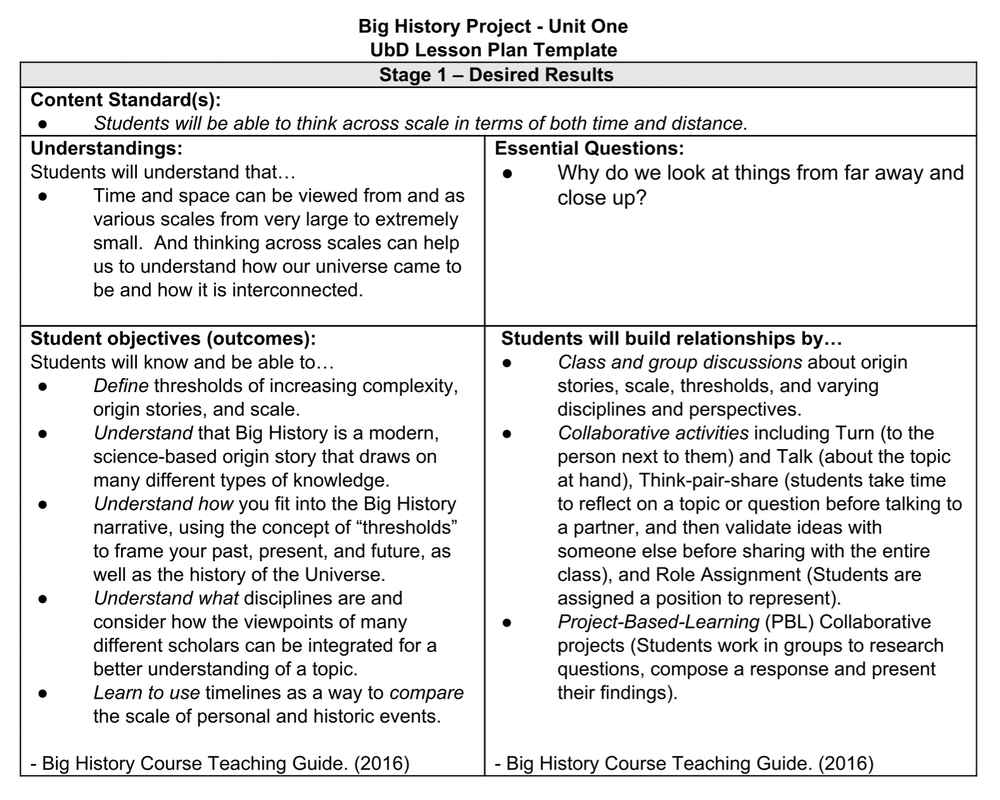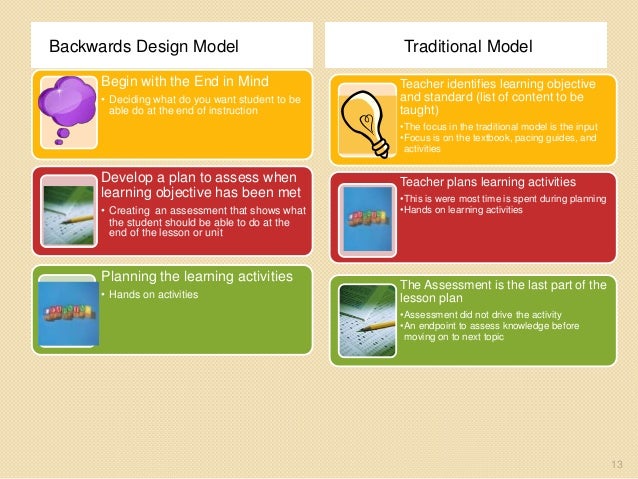Table Of Content

If they don’t see the relevance of what they’re learning or a direct line between the content of your course and a desirable outcome, they’ll tune it out. Sure, many students will do what you ask anyway, because they want good grades and the benefits that come from them. There are many resources, including templates and examples, available to help guide the Backward Design process.
Rigid Framework
Teaching methods will include direct instruction, inductive methods, cooperative learning, and group activities. The scope of your assessments should be in line with the outcomes, and the balance between concepts and skills in these assessments should match that presented in your ILOs. Moreover, in assessments, you should strive to measure the kind(s) of engagement described in your intended learning outcomes. If your ILO states that students will be able to describe some phenomenon, don’t use a true/false or multiple-choice question to measure their attainment of this outcome. How you evaluate and grade an assessment should also track with your intended learning outcomes.
UbD: Stages of Backward Design
By defining what students should know or be able to do by the end of a lesson, educators can offer a more targeted and effective learning experience. For instance, it's difficult to set specific, narrow learning goals for interdisciplinary courses like “Environmental Science” that integrate biology, chemistry, and social science. The challenge lies in encapsulating the breadth of these disciplines into a set of focused objectives without diluting the complexity and richness of the subject matter.
Alignment of learning objectives to learning activities
We also use the practice of assessment, as a whole, to inform our teaching. By looking at assessment as a cycle throughout the duration of a class, we can begin to see how assessment informs our teaching and learning activities. For every assessment[ we create, we want to engage in a cycle that has four stages (scroll over the question marks below). Teaching Excellence Academy workshop for University of Waterloo, Canada. Retrieved from Queens University, Matching Assessment Tasks to Learning Outcomes. Backward Design is a planning framework in which you start with the end in mind - the desired outcomes.

A downloadable guide for teaching professionals from the University of San Diego. Join the more than 100,000 creators who use Teachable to share their knowledge. Easily create and sell courses, coaching, and digital downloads with our powerful yet simple no-code platform. Get articles with higher ed trends, teaching tips and expert advice delivered straight to your inbox. Instead of starting with a topic, we’d do better if we start with an end goal, and that’s where backward design comes in. This is particularly burdensome for educators who may already be grappling with other responsibilities like grading, classroom management, and ongoing professional development.
Sometimes, the assessments do not match the learning goals, and it becomes a frustrating experience for students and instructors. Use the list below to help brainstorm assessment methods for the learning goals of the course. Educational theory for designing courses by starting with learning outcomes first, then creating assessments, and course activities. In the second stage of backward design, instructors create the assessments students will complete in order to demonstrate evidence of learning and even progress towards achievement of the learning objectives.
In backward design, educators start by identifying or creating a final assessment, then building their lessons toward that specific end. Traditionally, educators identify course content they need to cover, design their lessons accordingly, then create the final assessment. While the traditional approach may work in some cases, there are some significant flaws and challenges. The backward design model seeks to avoid those challenges by encouraging teachers to be much more intentional in their curriculum development and make the most out of class time. The first question listed above has instructors consider the knowledge that is worth being familiar with which is the largest circle, meaning it entails the most information.
A Backwards Approach to Material Innovation - ARCHITECT Magazine
A Backwards Approach to Material Innovation.
Posted: Fri, 22 Jun 2018 19:16:20 GMT [source]
Lives - Colleges and Universities - Education and Schools - Graphic Design - Studio Art - Detroit - The New York Times
Lives - Colleges and Universities - Education and Schools - Graphic Design - Studio Art - Detroit.
Posted: Sun, 30 Sep 2007 07:00:00 GMT [source]
Curriculum theorists like Jay McTighe have developed specific materials to assist educators in applying this method effectively. Curriculum theorist Jay McTighe, another co-creator of Backward Design, highlights how the approach can be adapted for different subjects, age groups, and educational settings. This adaptability makes it a popular choice for a wide range of educational contexts, from K-12 to higher education and corporate training. One of the most frequently cited challenges of Backward Design is the time commitment required for planning. Educators like Linda Darling-Hammond have noted that preparing comprehensive plans and aligning them with assessments and activities can take substantial time. Information that fits within this question is the lowest priority content information that will be mentioned in the lesson, unit, or course.
In contrast to the traditional “forward design” approach, backward design begins by establishing learning goals and then developing assessments and teaching methods to achieve the desired outcomes. Backward Design was described by Wiggins, Grant and McTighe (1998) in an attempt to redirect instructors’ focus from activities and instruction to the outcomes of instruction. This helps to address the misconception that the activity itself always leads directly to the desired learning, when, in fact, the activity may just start the process of engagement, curiosity, or understanding. No matter how many times you have led your class, there are always seemingly small tweaks, edits and changes that you can make. This may be prompted by feeling lukewarm about how an activity went, how students performed on an assessment, feedback from students, or even just changes in your students or course.
As you can see, there are lots of advantages to implementing backward design lesson plans into your curriculum or teaching schedule at the earliest opportunity. Fortunately, using backward design lesson planning is easy once you make a few classes or courses with this philosophy in mind. Collaboration can provide invaluable insights and make the planning process less burdensome. Teams of teachers often find it easier to brainstorm learning goals, assessment methods, and instructional strategies. Renowned educator Carol Ann Tomlinson, who we mentioned earlier, supports the idea of collaborative teaching and planning.
Imagine planning a road trip by first thinking about the destination, and then figuring out all the best stops and routes along the way. The knowledge and skills at this substage are considered important to know and do. The information that fits within this question could be the facts, concepts, principles, processes, strategies, and methods students should know when they leave the course.
Instructional activities are the specific ways in which students interact with the course content. These activities run the gamut from watching educational videos, creating posters or presentations, completing a group project or playing learning-based games. Successful lesson plans often contain a mix of instructional strategies and activities, since asking students to adapt to different modes of learning is an effective way to keep them engaged. Grant Wiggins and Jay McTighe introduced backward design in their book Understanding by Design.
The goals for your course should not be stated in terms of what the instructor will cover, but rather in how the students will change, facilitated by the instructor’s guidance. Interested in more professional development opportunities for teachers? Explore education courses and certificates at the University of San Diego’s Division of Professional and Continuing Education. In no time at all, you might see improvements in the performance of your students, the quality of your classes, and the ratings of your online lessons. Check out this backward design lesson plan template from Vanderbilt University.
I taught that book a few times, and even though I looked forward to it every time, I always finished the unit a little unsatisfied. When I taught seventh grade language arts, one of my favorite things to teach was S.E. After we did some reflecting, writing, and talking, we were ready to start the book. For those new to Backward Design, diving in with an entire curriculum may feel overwhelming. Educational consultant and author Heidi Hayes Jacobs recommends starting with a single unit or even just one lesson.

No comments:
Post a Comment